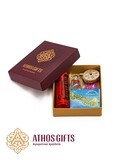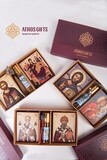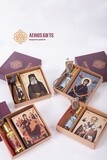The gift set consists of 4 items: baptismal cross, myrrh, komboskini bracelet and an amulet with an image of. St. Pantaleon.
Orthodox cross: history and symbolism
The Orthodox Church honors the Cross as a great relic symbolizing the redemption of the human race. The honorable Cross of the Lord for the Christian faith is the highest symbol of sacrifice and sanctification, and therefore its significance is truly invaluable. The Cross and the Resurrection are the two main axes of Christianity: the Resurrection follows the Cross and implies the Cross, and the Cross predicts the Resurrection.
Before Christ was crucified for our sins, anyone who died through crucifixion was considered damned. After Jesus died on the cross, it became a symbol of redemption. From an instrument of death the cross became an eternal source of life, from a horrible instrument of execution it turned into a light and blessed sign.
This paradox and great change came about because immeasurable divine love and mercy did not avenge human ignorance and evil. The all-redeeming divine love leaves no room for hatred, anger, and malice. God as absolute love, instead of vengeance, had mercy on mankind, giving redemption from the bitter bonds of sin and evil, giving mankind eternal life. After the crucifixion, the cross became associated with the Lord Jesus Christ, drawing from Him its invincible power, sanctification and grace. That is why the worship of Christians to the Cross is not idolatry; it is the worship of Christ Himself. Christians proudly wear the cross in memory of the great atoning sacrifice and as an effective bulwark against evil.
The honorable Cross of the Lord is the unifying force of mankind. The two crossbars of the Cross symbolize the union of men with God (the vertical crossbar) and the union of men with one another (the horizontal crossbar). The last one also symbolizes the two arms of the Crucified Savior, which are open to embrace all mankind.
Amulets
Fabric amulets are small bags, most often with church symbols or images of saints. They are usually filled with incense or other small objects.
Amulets are used as talismans; for these reasons they are often attached to clothes with a pin, and sometimes worn around the neck on a cord. The amulets can also be attached to the headboard of the bed.
Saint Pantaleon
Saint Panteleimon was born in Nicomedia under the name of Pantoleon. His father was a noble pagan and his mother, St. Eubula, was a Christian. His mother wanted to bring up her son in the Christian faith, but unfortunately she died early. So it was up to his father to educate the boy; he sent him to a pagan school, and then to the famous Nicodemian physician, in which science the young man has excelled.
In Nicomedia Pantoleon became acquainted with the presbyter Hermolaus, who introduced him to the Christian faith. After some time he has witnessed a miracle: Pantoleon saw a child killed by a snake bite, and started to pray to Jesus Christ; only by the power of that prayer he resurrected the child. After this miracle, Pantoleon was baptized with the name Panteleimon and devoted his life to the suffering and sick. On the denunciation of other physicians the saint fell foul of the emperor Maximian, who though he favored Panteleimon, was a pagan and an ardent opponent of Christianity. In order to force the saint into renouncing his faith, Panteleimon was subjected to many tortures, all of which he endured with Christian fortitude and humility. After this, in the year 305, the martyr was beheaded.
The Saint Panteleimon Monastery on Holy Mount Athos stores the main holy relic - the head of the Great Martyr and Healer Panteleimon, as well as his icon, where the saint is depicted in full length, framed by 14 small images relating to scenes of his life. The monks believe that St. Panteleimon is the patron saint of Saint Panteleimon Monastery: twice he has miraculously saved it from devastating fires.
Komboskini bracelets
Greek komboskini bracelets are woven by the monks of the Mount Athos monasteries with prayer and for prayer. The name of the bracelet reflects its essence and purpose: in Greek, kombos (κόμπος) means "knot", and skini (σχοινί) is a rope or cord.
The weaving of the komboskini bracelets is always accompanied by continuous prayer. Tying each knot, monks say: "Lord Jesus Christ, have mercy on me." Due to this, Greeks believe that komboskini bracelet protects the person who wears it. But the bracelets also have a more practical use: like prayer ropes, they are used by the prayers to go through the knots and thus count the number of prayers uttered.
Bracelets are braided in a special way: each knot consists of 9 crosses of cord, symbolizing the nine crosses, or nine angelic ranks. Often seed beads, little crosses or icons are woven into the bracelet. Komboskini bracelets are usually worn on the wrist of the left hand, as it's closer to the heart. Believers often give such bracelets to their family and friends to remember and pray for them.
Similar Products
Light a candle
You can light a candle in the monasteries of St. Athos
Submit a note
Submit a memorial note to the monasteries of Athos
Mount Athos Shop
Handmade products by the monks of Holy Mount Athos
Transportation on Mount Athos
Book a vehicle for travelling on Holy Mountain
Diamonitirion
Obtain a visa to the Holy Mountain. Guarantee of issuance
Athos cruise
A tour along the west coast of the Holy Mountain on a cruise ship
Submit tamas
We will deliver your tamas to the icon of your choice




